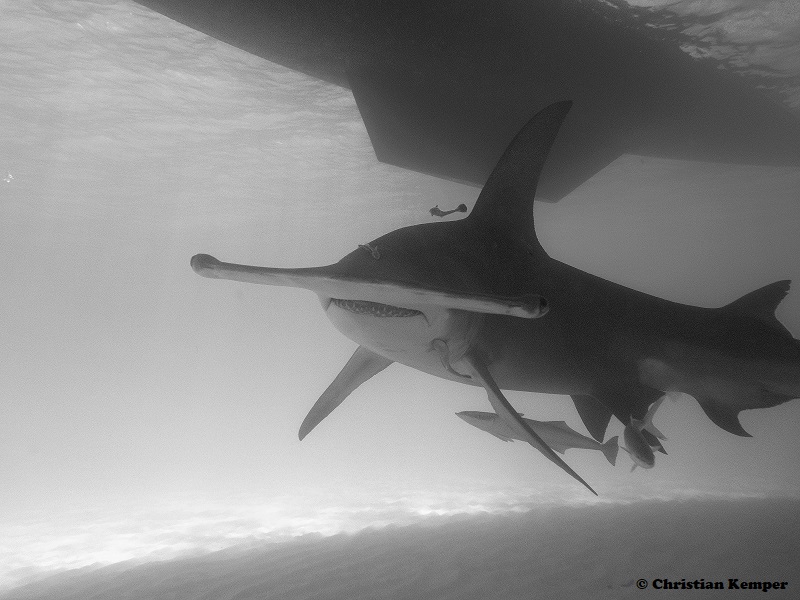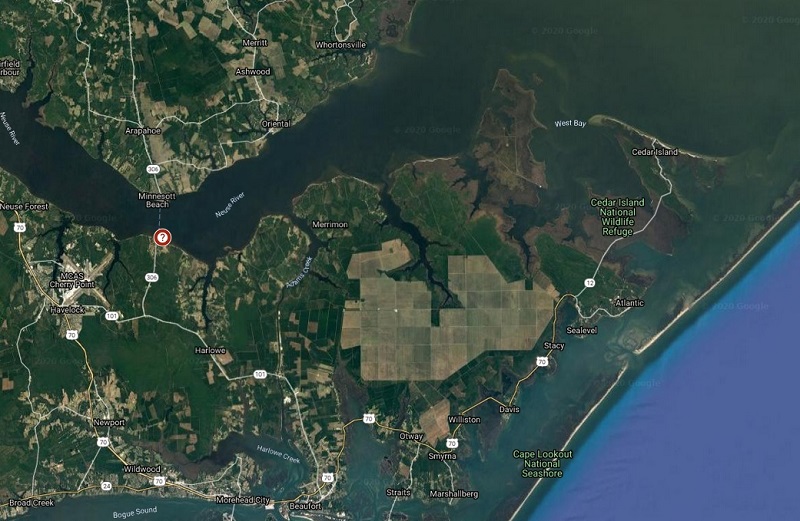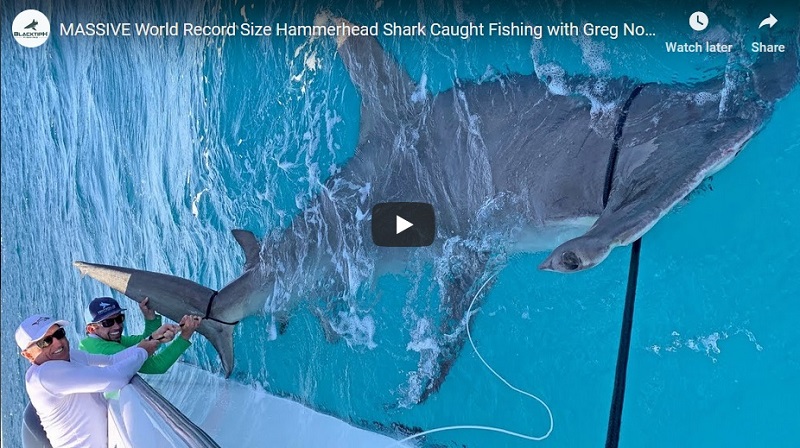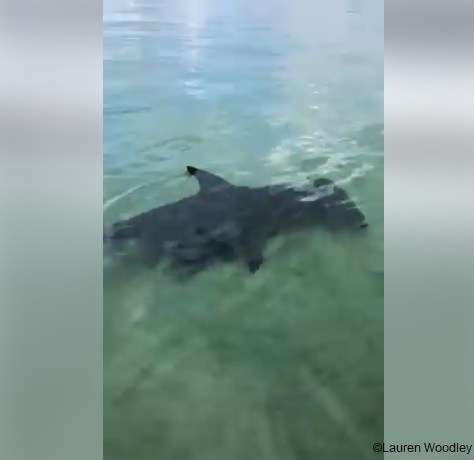The weather forecast dictates the departure for Bimini in the morning. From January to April you have the chance to get a great hammerhead shark (Sphyrna mokarran) to the bait box. Of the instantly recognizable organisms in the animal kingdom, the hammerhead shark is probably among the top three.
![]()
That distinctive skull design, molded by 400 million years of evolution, gives the large coastal shark its perfectly suited name. But many a tarpon fishing guide in the Bahamas can also instantly identify a hammerhead shark by its tall sickle-shaped dorsal fin, and the feeling of dread that follows knowing another angler’s trophy catch may fall prey to it.
A large hammerhead appears menacing. It seems intent on causing harm. Those soul-piercing eyes on either end of its skull, connected to a specialized nervous system which allows it to see and hunt successfully, a face only a hammerhead mother could love. The very sight of it strikes fear into the hearts of many beachgoers and boaters. But the hammerhead’s looks could not be more deceiving.
It is one of the most gentle, docile and mislabeled animals on this planet. In fact, of all the human shark bites recorded in history, according to the International Shark Attack File, only 17 unprovoked bites have been attributed to the hammerhead, and none were fatal. Truth be told, what should fear a large hammerhead shark are most are stingrays, blacktip sharks and tarpon.
Even if you have been very successful in recent years, you do not dare to guarantee seeing the animals. It is still nature where luck is involved! We keep our fingers crossed for the 12-hour crossing south from Tiger Beach.
On the way, our Captain Levente asks us if we would like to go to the dolphins as well? Is the pope Catholic? When and where?
“At some point in the late afternoon,” he says. Sure, of course! Shortly before Bimini we reach the feeding grounds of the spotted dolphins. With daring leaps, they greet us—or each other. We jump with mask and snorkel into the water and into the fray!
Around 30 dolphins are waiting for us. These are wild animals, and yet we feel like we’re in Sea World, they act so confidently. They are incredibly fast and hiss around us. We enjoy it for a few moments until we find a juvenile who’s interested in us and follows us around. It challenges us to play with him. But first, please smile and look into the camera! Thanks! So now off with the camera and follow the invitation. All too soon, two larger animals approach. Maybe the parents.
Those three animals follow us. I get carried away. When I look up, I do not see our boat anymore! Then, 200 meters in the distance, I see it. Did they keep going while I played with the dolphins? No, the current has driven me away from the boat! Now I’m a bit queasy, I’m alone in the water, and 200 meters in the open ocean is quite a distance to swim!
![]()
Didn’t we see tiger sharks near the dolphins yesterday? If they are lurking nearby, that could be fatal for me. I swim to the boat as fast as possible and reach it after what felt like an eternity.
Only 79 km east of Miami Beach are the Bimini Islands (North and South Bimini). They are in the middle of the Gulf Stream, which ensures the enormous fish wealth. Every year in spring there is a chance to meet the rather rare and shy great hammerhead sharks, who are extremely active here off the coast of Bimini and ready to interact with the divers.
The great hammerhead shark is the largest shark within the family of hammerhead sharks (Sphyrnidae) with a maximum size between 5.5 and 6.1 meters. He lives worldwide in the tropical and subtropical coastal areas and the continental shelf, where he prefers coral reef as a habitat. It differs from other hammerhead sharks mainly by the expression of the hammer-shaped enlarged head as well as its very large and crescent-shaped first dorsal fin. He is a loner and feeds on a variety of invertebrate animals and bone and cartilaginous fish, including small sharks and representatives of their own kind.
The main prey, however, are rays, especially stingrays, which he tracks through the sensory organs located on the head. Like all other great hammerhead sharks, this species is considered potentially dangerous to humans, however shark accidents with hammerhead sharks are very rarely documented. Due to his large fins and his skin, he is hunted commercially, and is classified by the International Union for Conservation of Nature (IUCN) as endangered.
Like no other island state in the Caribbean, the Bahamas are entwined with legends and myths: It is said that the remains of the legendary Atlantis are to be found on Bimini. In 1968 divers even discovered mysterious ruins under water. They found an immense series of precisely aligned limestone blocks off the island which were estimated to be up to 10,000 years old. Many were convinced they had the lost city of Atlantis ahead of them. To this day, explorers and adventurers are feverishly diving to the relics to find evidence of their theories.
Of course, it is not certain that Atlantis will be here, but you do know where the mysterious fountain of youth lies, which the Spanish conqueror Ponce de Leon had already sought. On Bimini, proudly presented by the locals, is the so-called “healing hole,” to which rejuvenating powers are credited. In fact, this source of water is remarkably rich in minerals and certainly has health promoting powers.
![]()
Diving into the fabulous underwater world—that’s what scuba divers want on Bimini. It’s no surprise, of course, that in addition to the excellent fish abundance, Bimini also has fabulous snorkeling opportunities. Just off the coast of South Bimini lies the impressive shipwreck Sapona on the seabed. Built in North Carolina and authorized by Woodrow Wilson during the First World War, it sank during a hurricane in 1926.
The feeling of having discovered something special here is confirmed when we jump into the sea with snorkeling equipment. As soon as we put our heads under water, we meet the first turtle. With relish, she grazes the small-leaved seaweed at a depth of barely two meters and digs for its starchy roots. A few minutes later, we already count half a dozen of these smart armored vehicles that are in no way bothered by us. The gently sloping seagrass bay is obviously their lunch. But not only for them, because we also see 15-20 stingrays and two eagle rays during our two-hour snorkeling!
Another spot worth seeing is Piquet Rocks, a large wreck of a Spanish ship full of rocks and cannonballs. Depending on the air consumption of the guests, up to two tanks per person, indefinitely, are dipped. Since the water is very shallow there, the dives can easily last up to 1.5 hours.
During the trip to North Bimini we throw the fishing rod out again and again and catch a barracuda. As we wriggle on deck, our Captain asks for alcohol.
“Does anyone have whiskey or something?” Levente wants to know. Does he have to drink to kill the fish? In fact, I have a hip flask with 18-year-old single malt scotch, a Tobermory, with 58.6% cask strength, a high percentage drop. “Pour something in his gills!” Excuse me? “Alcohol is a poison, even people can die from alcohol poisoning. If you pour the alcohol over the gills, the fish will die faster than if you hit it on the head with a club or try to hit it in the heart with a knife. Thus, the fish must suffer less,” Levente explains.
![]()
Said and done. I pour the precious whisky over the gills and after five seconds the fish stops moving. Dead. Crazy! That was worth it. Now we have fresh bait for the sharks! Another time we catch a 1.30 m long “Mahi mahi” (Coryphaena hippurus). Our chef Deborah Starbuck processes it into delicious sushi. Head and tail are bait for the sharks.
In hunting, the Mahi mahi can reach a speed of 60 kilometers per hour, making it one of the fastest fish. It also jumps out of the water for up to six meters in pursuit of her prey, the flying fish. The flying fish (Exocoetidae) are omnipresent and amaze me again and again as I chill on the catamaran’s deck. Unlike the South American freshwater hatchetfishes, flying fish cannot use their pectoral fins actively to fly like birds. At a speed of 30 km/h, the swarms break through the water surface. Then they use their caudal fin with high speed until they glide over the water surface at 55-60 km/h. By spreading their pectoral fins, they sail through the air. A single “flight” can take 30 seconds or more and cover a distance of 400 meters. Mostly, however, the jumps are shorter.
This concludes Searching for great hammerheads, The Bimini Adventure, Part 1. Check back next week for part 2.
![]()
Christian Kemper is a TV journalist from Germany and freelance writer for three of the biggest diving magazines in Germany. He has been diving with and studying sharks for more than 20 years. The author has written two books about shark attacks and is about to publish his first English language book about sharks titled “The Fear Beneath.”
You can find his German Language book Strange Pool Friends on Amazon and at tredition.
He has also written a three part article about diving with tiger sharks.



